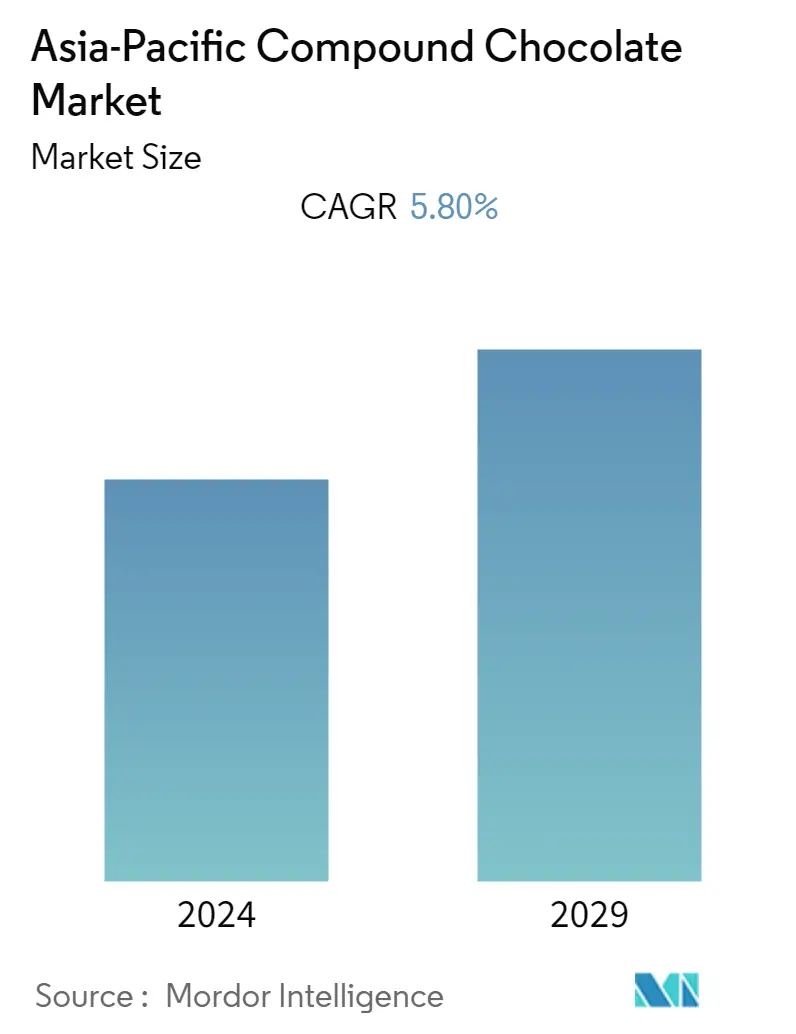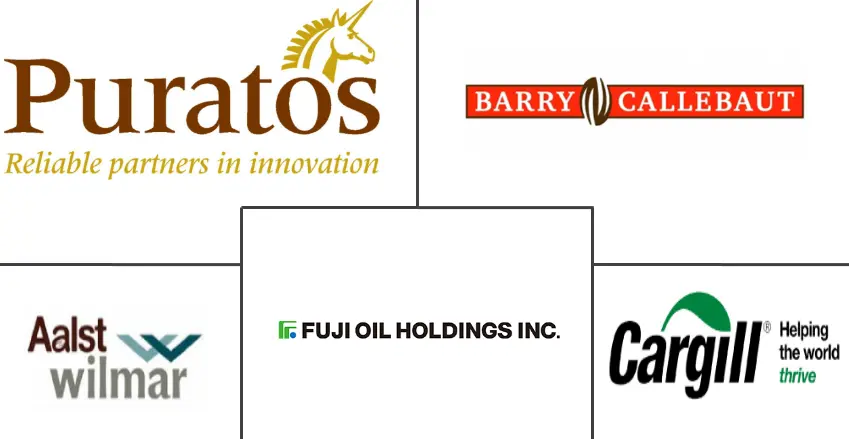Market Size of Asia-Pacific Compound Chocolate Industry

| Study Period | 2019 - 2029 |
| Base Year For Estimation | 2023 |
| Forecast Data Period | 2024 - 2029 |
| Historical Data Period | 2019 - 2022 |
| CAGR | 5.80 % |
| Market Concentration | Low |
Major Players
*Disclaimer: Major Players sorted in no particular order |
Asia Pacific Compound Chocolate Market Analysis
The Asia-Pacific compound chocolate market is projected to grow at a CAGR of 5.8% during the forecast period.
- The primary factor driving the market for compound chocolates is the robust demand for the product from the expanding food and beverage industry in the country for various applications, such as bakery, confectionery, frozen dessert, ice cream, beverages, cereals, and others.
- In addition, the bakery industry in the country is also emerging as the lucrative application sector amid the growth of artisanal baked commodities, thereby, aiding the growth and demand for compound chocolates.
Asia Pacific Compound Chocolate Industry Segmentation
The Asia-Pacific chocolate market is segmented by type that includes dark chocolate, milk chocolate, and white chocolate. Based on form, the market is divided into chocolate chips/drops/chunks, chocolate slab, chocolate coatings, and other products. By application, the market is classified into the bakery, confectionery, frozen desserts, and ice-cream, beverages, cereals, and others. The study also involves the analysis of regions such as China, Japan, India, Australia and the rest of Asia-Pacific.
| By Type | |
| Dark Chocolate | |
| Milk Chocolate | |
| White Chocolate |
| By Form | |
| Chocolate Chips/Drops/Chunk | |
| Chocolate Slab | |
| Chocolate Coatings | |
| Other Products |
| By Application | |
| Bakery | |
| Confectionery | |
| Frozen Desserts and Ice-Cream | |
| Beverages | |
| Cereals | |
| Others |
| Geography | |||||||
|
Asia-Pacific Compound Chocolate Market Size Summary
The Asia-Pacific compound chocolate market is experiencing significant growth, driven by the increasing demand from the expanding food and beverage industry. This demand spans various applications, including bakery, confectionery, frozen desserts, ice cream, beverages, and cereals. The bakery sector, in particular, is emerging as a lucrative area for compound chocolate due to the rise of artisanal baked goods. Despite concerns about sugar intake, consumers continue to seek indulgent treats, with a trend towards premiumization evident in the growing popularity of dark chocolate. The introduction of dark milk chocolate offers a balance between the richness of dark and the smoothness of milk chocolate, catering to evolving consumer preferences. The market is characterized by a focus on healthy eating, convenience, and variety, with compound chocolate being favored for its cost-effectiveness and ease of use in baking, as it does not require tempering and has a long shelf life.
The Asia-Pacific compound chocolate market is highly fragmented, with numerous players vying for market share. Key industry participants, such as Cargill, Puratos, The Barry Callebaut Group, and Fuji Oil Holding Inc, are actively engaging in strategies like new product launches, expansions, mergers, acquisitions, and partnerships to enhance their market position. These efforts are aimed at gaining a competitive edge and solidifying their presence in the market. The absence of cocoa butter in compound chocolate not only offers cost savings but also meets the demand for products that align with consumer trends towards healthier and more convenient options.
Asia-Pacific Compound Chocolate Market Size - Table of Contents
-
1. MARKET DYNAMICS
-
1.1 Market Drivers
-
1.2 Market Restraints
-
1.3 Porter's Five Forces Analysis
-
1.3.1 Threat of New Entrants
-
1.3.2 Bargaining Power of Buyers/Consumers
-
1.3.3 Bargaining Power of Suppliers
-
1.3.4 Threat of Substitute Products
-
1.3.5 Intensity of Competitive Rivalry
-
-
-
2. MARKET SEGMENTATION
-
2.1 By Type
-
2.1.1 Dark Chocolate
-
2.1.2 Milk Chocolate
-
2.1.3 White Chocolate
-
-
2.2 By Form
-
2.2.1 Chocolate Chips/Drops/Chunk
-
2.2.2 Chocolate Slab
-
2.2.3 Chocolate Coatings
-
2.2.4 Other Products
-
-
2.3 By Application
-
2.3.1 Bakery
-
2.3.2 Confectionery
-
2.3.3 Frozen Desserts and Ice-Cream
-
2.3.4 Beverages
-
2.3.5 Cereals
-
2.3.6 Others
-
-
2.4 Geography
-
2.4.1 Asia Pacific
-
2.4.1.1 China
-
2.4.1.2 Japan
-
2.4.1.3 India
-
2.4.1.4 Australia
-
2.4.1.5 Rest of Asia-Pacific
-
-
-
Asia-Pacific Compound Chocolate Market Size FAQs
What is the current Asia-Pacific Compound Chocolate Market size?
The Asia-Pacific Compound Chocolate Market is projected to register a CAGR of 5.80% during the forecast period (2024-2029)
Who are the key players in Asia-Pacific Compound Chocolate Market?
Cargill Incorporated, Puratos, The Barry Callebaut Group, Aalst Wilmar Pte Ltd and Fuji Oil Holding Inc are the major companies operating in the Asia-Pacific Compound Chocolate Market.

